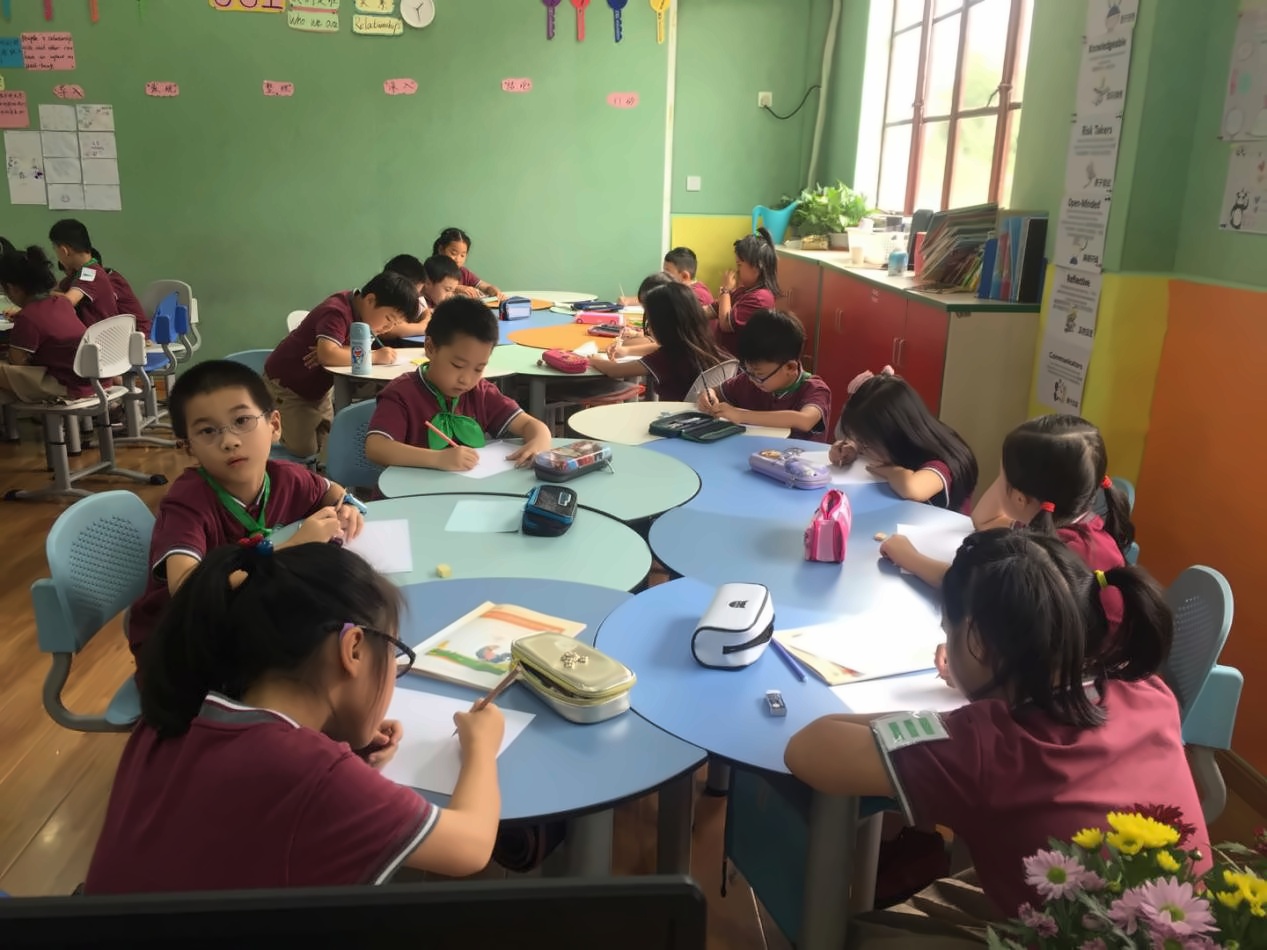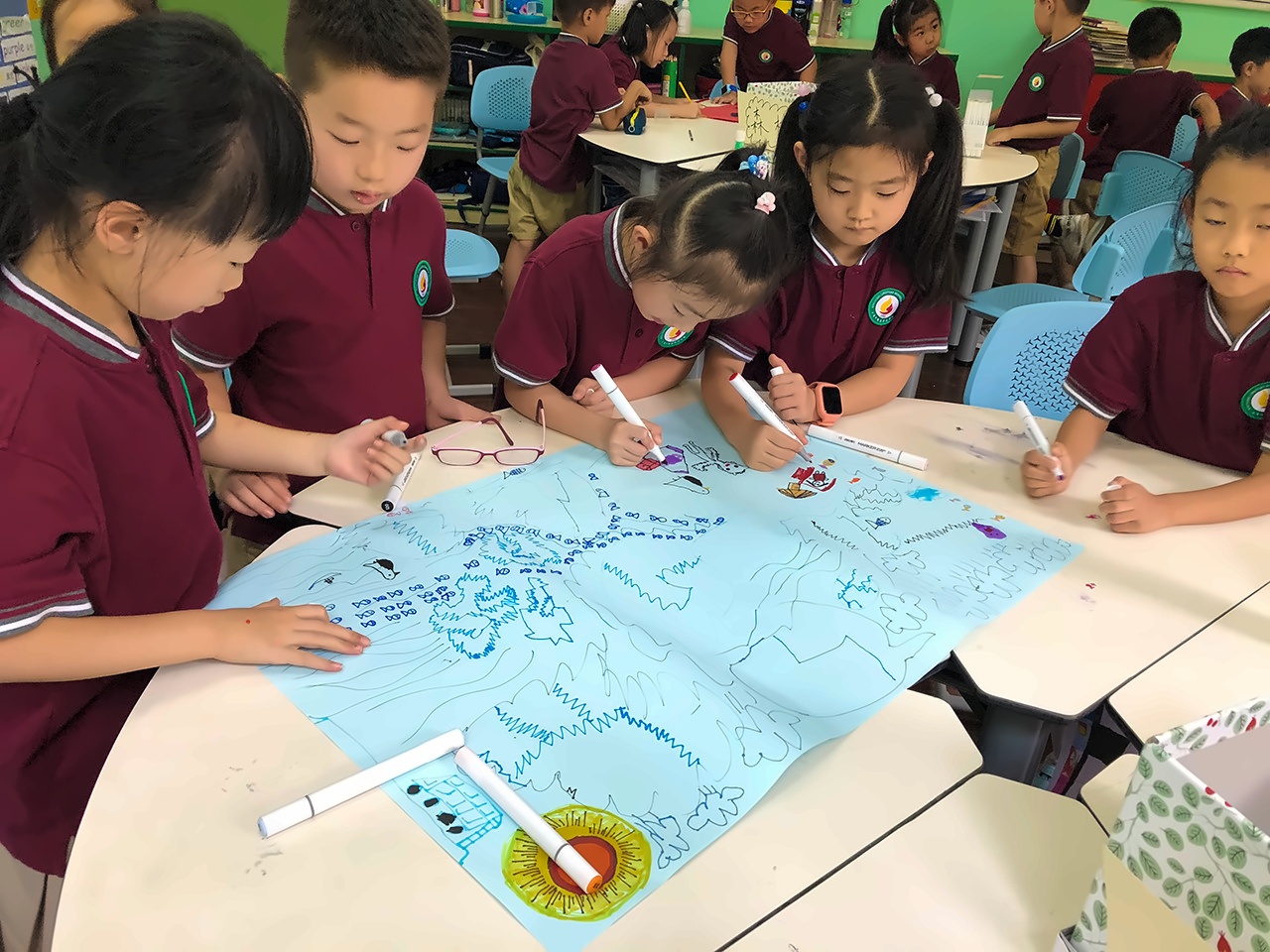全國統一學習專線 8:30-21:00
來源: 上海燎原雙語學校 編輯:佚名
2018年7月,上海燎原雙語學校國際部通過了小學 IB PYP 項目認證,正式成為了一所 IB 世界學校。以下是上海燎原雙語學校國際部IB課程一周簡報。
Grade1
這個單元我們探究生物與非生物,孩子們在學習了動物的棲息地以后,知道了每個棲息地都住著不同的動物。照片中我把五個棲息地放在教室的不同位置上,讓頭戴動物頭飾的小朋友自己去找找棲息之地,并說說我為什么喜歡住在這里,大家都很開心。
This unit explores both living and non-living things, and after learning about the habitats of animals, children learn that each habitat is inhabited by different animals. In the picture, I put five habitats in different places in the classroom, let the children wearing animal headgear find their own habitat, and said why I like living here, everyone is very happy.

燎原IB課程
這周:他們的任務是借助繪畫工具,學生找到自己喜歡的棲息地分組,討論棲息地動物的共同點,制作海報。并且準備以演講的形式說了出來。 在最終的演講環節,我們的探究教室化身成了畫室。班級與班級之間互相聆聽每個小組的演講,并且互相提問,進行了互評、質疑。好評最多的小組還會獲得掌聲表示鼓勵,你看小朋友們那認真的樣子,真有一些小小演說家的樣子。
This week: Their task is to use drawing tools to help students find their favorite habitat groups, discuss the common ground of habitat animals, and make posters. And ready to speak in the form of speeches.In the final speech session, our inquiry classroom became a studio. Classes and classes listen to each other's speeches, ask questions, comment and question each other. The group that received the most praise received applause and encouragement. Look at the serious manner of the children. There are some small speakers.
這兩周,我們一(3)班小朋友先討論一下什么是生存環境以及在不同的生存環境中動物是怎樣生存的,然后選擇海洋、森林、沙漠、草原等棲息地,小組合作溝通交流,一同完成棲息地作品。
This: Two weeks, we G1(3) first discuss what is the living environment and how animals live in different living environment, and then choose the ocean, forest, desert, grassland and other habitats, group cooperation and communication, together to complete the habitat works.
在探究課上,孩子們積極參與討論什么是生物,什么是非生物。以小組繪畫的形式,深入感知五大棲息地,及各棲息地適合生存的生物。在操場上,孩子們認真地尋找生物,很多孩子都找到了螞蟻。瞧!他們各個專心致志地觀察著螞蟻的外形,活動方式,來更深入地了解生物的生活習性。孩子們在合作的過程中,都愿意幫助他人,也能彼此認真地耐心地傾聽同伴的想法,然后把大家的想法都融合在繪畫中,團隊合作精神非常棒!
In inquiry class, children are actively involved in discussing what is biology and what is abiotic. In the form of group painting, we have a deep understanding of the five habitats and the habitats that all habitats are suitable for survival. On the playground, the children were looking for life seriously, and many children found ants. Look! Each of them is devoted to observing the shape and movement of the ants in order to gain a deeper understanding of their living habits. In the process of cooperation, children are willing to help others, but also each other seriously and patiently listen to the ideas of their peers, and then put everyone's ideas into the painting, team spirit is very good!
通過兩周的學習,小朋友們已經了解清楚了什么是生物、什么是非生物。孩子們根據自己已有的認知,畫出了五個棲息地上生存的生物,這五個棲息地分別是:草原、雨林、海洋、沙漠、極地。(UOI墻圖片)老師請小朋友上臺和全班分享自己小組的作品,說一說自己的小組成員在棲息地上都畫了哪些生物,這些生物為了適應棲息地都有什么特點。小朋友們在分享的過程中不僅增長了知識,同時也鍛煉了合作及交流的能力。
Through two weeks of study, children have learned clearly what is living things and what is abiotic. The children painted five habitats, grasslands, rain forests, oceans, deserts and polar regions, based on what they already knew. (UOI Wall Photo) The teacher asked the children to come to the stage and share their group's work with the class. He said what creatures were painted on the habitat and what characteristics these creatures had in order to adapt to the habitat. In the process of sharing, children not only gain knowledge, but also develop the ability of cooperation and communication.
小朋友什么是生物什么是非生物呢?有個很可愛的小朋友說,老師非生物就是飛在天上的生物。哈哈哈!太棒了,跟著老師一起帶著問題進入到我們的探尋課吧!小朋友在激烈的辯論,歸類及合作分類的方式中,發現了生物與非生物的差異,定義孩子們脫口而出。在午后孩子們積極主動申請去尋找校園中的生物與非生物。老師看著他們的勁兒都非常開心,在快樂的玩耍當中,**領悟知識要點。孩子根據自己的興趣去選擇棲息地,然后小組合作。
What are children, creatures and abiotic creatures? A very lovely child said that the teacher's abiotic creatures are flying creatures in the sky. Ha ha ha! Great! Let's go to our exploration class with the teacher together with problems. In heated debates, classifications and cooperative classifications, children find differences between living and non-living, and define what they blurt out. In the afternoon, children actively apply to find biological and abiotic elements on campus. The teacher looked at their strength and was very happy. He learned to understand the main points of knowledge in happy play. Children choose their habitat according to their interests, and then work together in groups.
孩子們的想象力超乎了老師的想像,孩子的辯論表達能力也給了老師一個驚喜。在合作互動的探究氛圍中,孩子們學到并且收獲快樂。才一周多的時間。所有的孩子都開心的擁抱老師說,老師老師!我超級超級喜歡探究課。
The children's imagination exceeded the teacher's imagination, and the children's ability to debate and express surprises to the teacher. In the cooperative and interactive inquiry atmosphere, children learn and harvest happiness. More than a week. All the children are happy to hug the teacher, teacher, teacher, I super super like inquiry class.
小朋友們對我們身處的地球充滿好奇,一個個和我們人類一樣擁有生命力的生物給孩子們帶來了不一樣的世界,極地、海洋、沙漠、草原、雨林,不同的生物擁有不同的特點,也有相似的地方,孩子們用自己的發現美的眼睛,充滿想象力的大腦和勤勞的雙手慢慢地探索著我們的大自然,慢慢地探索著世界......
Children are full of curiosity about the earth in which we live. One by one, like our human beings, has brought children a different world. Polar, ocean, desert, grassland, rain forest, different creatures have different characteristics, but also similar places. Children use their own eyes to discover beauty. The imaginative mind and the industrious hands slowly explore our nature, slowly explore the world...

IB課程
Grade2
學習了水的三態,我們開始探索我是誰,在現在和將來的人際關系中,我們的角色都發生著哪些變化。
After learning about the three states of water, we began to explore who I was and what changes were taking place in our roles in current and future relationships.
討論完動畫片中的各種關系后,我們一起完成小組任務。多有趣啊!
After discussing the various relationships in the cartoons, we finished the group task together.How interesting!
我們一起探討家庭關系和社會關系,我發現我們身邊關系錯綜復雜。
We talked about family relationships and social relationships, and I found that we were surrounded by complex relationships.
原來我們的生活中有這么多的關系嗎,我們來給它們分分類吧!
It turns out there are so many relationships in our lives that let's classify them.
進入Finding Out環節—我們首先觀看了四種動畫片,思考影片中的人物關系是怎么樣的?他們之間的關系是如何發展的?然后,我們小組內探討并合作完成關系圖。最后,我們向大家展示作品并及時做出反思。
In Finding Out, we first watched four cartoons and thought about the relationship between the characters in the movie. How did their relationship develop? Then, we discussed and worked together to complete the chart. Finally, we show you the work and reflect on it.
通過討論我們最喜歡的動畫片,如《西游記》,我們可以畫出并寫下關系圖,讓我們更好地理解關系。
By discussing our favorite cartoons, such as,Journey to the West, we can draw and write down relationship diagram, which lets us understand relationships better.
Grade3
小組展示的“大氣”成員最為齊全,氮氣、氧氣、一氧化碳、二氧化碳、水蒸氣……
This team completely showed "atmosphere" members, nitrogen, oxygen, carbon monoxide, carbon dioxide, water vapor……
在巖石中,他們發現了“黃金”,雖然不太確定金戒指、金項鏈怎么也是“石頭”,但是孩子們對自己的發現表現得興奮不已。
In the rock, they found "gold", although they are not sure how gold ring, gold necklace have became "stone", but the children are excited about their discovery.
小組的展示很新穎,圖文并茂,想象力和創造力得到了很好的提高。
The group presentation with pictures and texts is very novel, and the imagination and creativity have been greatly improved.
本周,我們在課堂上,主要的任務是搜集資料。我們在課堂上觀看了許多關于地球地形、地貌的紀錄片。在課下同學們也搜集了許多書籍。
This week, in class, our main task is to collect information. We watched many documentaries about the earth's topography and landform in class. Students also collected many books after class.
Grade4
G4C1
本周我們回顧了上周的導入內容,并根據電影超人總動員來判斷主角們是什么個性,加以分析。在了解不同個性的基礎上完成自評和他評。
G4-1 students reviewed what they did in “Tuning In” last week, and then watched the film “The Incredibles” in order to analyse and determine the personality-types of the main characters. Having gained an understanding of different personalities, they were then able to evaluate themselves and their classmates.
G4C2
G4-2學生反思自己的性格特質,同時了解一下別人眼中的自己。性格沒有優劣之分,重要的是發現自己性格中的不足,試著學習去改變,培養不同的興趣,態度和技能。其實每個人都是幾種特質的共同體,自測一下,你最突出的特質是什么?
G4-2 students reflected on their own personality traits and by doing so got an understanding of how other people see them. There are no “good” or “bad” personality-types; the important thing is to recognise the shortcomings in one’s own personality and try to improve, cultivating new interests, attitudes and skills. In fact, every person has a mix of personality-types; the situation is not black-and-white. But by examining themselves, students were able to think about which of their traits is the most prominent.
上海燎原雙語學校報名、校園參觀及了解招生動態,請: ,或通過下方報名通道登記。